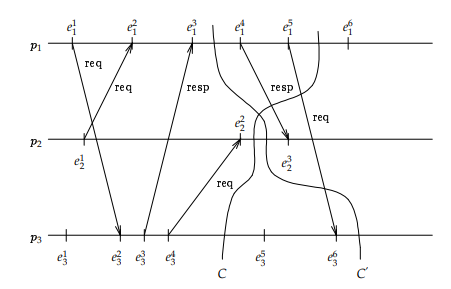Through concepts like global predicate evaluation, consistency checks, and innovative clock mechanisms, this research paves the way for more reliable and efficient distributed systems.
The Challenge of Global States
A distributed system comprises multiple processes that communicate solely through message passing without shared memory. This architecture complicates the construction of a global state, which is the union of the states of all processes involved. Due to communication delays and variations in processing speeds, the challenge lies in ensuring that the global states constructed are meaningful and consistent.
Mechanisms for Achieving Consistency
The authors explore two primary strategies for constructing consistent global states:
-
Active Monitoring: In this approach, a monitor process actively queries other processes for their states, constructing a global state based on their responses. While straightforward, this method can lead to inconsistencies if not managed carefully, as message delays can create misleading snapshots of the system.
-
Passive Observations: This strategy involves the monitor process observing events as they occur and constructing an observation of the system's execution. By adopting a causal delivery mechanism, the monitor can ensure that the observations made are consistent with the causal relationships between events.
Logical and Vector Clocks
To tackle the unpredictability of communication delays, the authors introduce two types of clocks:
- Logical Clocks: These provide a way to timestamp events in a manner that allows for the preservation of causal relationships without relying on synchronized real-time clocks.
- Vector Clocks: A more advanced mechanism, vector clocks capture the causal precedence among events by maintaining a vector of counters for each process. This allows for a more nuanced understanding of event ordering and consistency across distributed systems.
Applications and Implications
The practical implications of consistent global states are vast, impacting areas such as distributed debugging and deadlock detection. By establishing a robust framework for evaluating global predicates, the authors highlight how such mechanisms can be adapted to various scenarios, including handling multiple monitors and failures.
Key Concepts
- Global State: The global state of a distributed system is the union of the states of all individual processes within that system. Since processes communicate through messages without shared memory, a process must infer the states of remote components through message exchanges.
- Asynchronous Distributed Systems: These systems are characterized by the absence of bounds on the relative speeds of processes and message delays. This means that communication can be delayed unpredictably, and processes may execute at different rates.
- Global Predicate Evaluation (GPE): This is the problem of determining whether the global state of a distributed system satisfies a specific predicate (Φ). Global predicates encode properties of interest in terms of state variables. GPE aims to determine whether a global state satisfies a specific condition or predicate (Φ). This is crucial for solving numerous distributed computing problems, such as deadlock detection and debugging.
- Consistent Global States: A global state is considered consistent if it could have been constructed by an idealized observer external to the system. Consistency requires that all causal relationships between events are respected.
- Consistency: A global state is consistent if it could have been observed by an idealized external observer, meaning that it respects the causal relationships between events. Causal precedence is used to define this relationship, ensuring that if one event affects another, the former must be recorded before the latter in any observed global state.
- Causal Precedence: This is a relation defined over events in a distributed computation, where an event e is said to causally precede another event e' (written as e → e') if either e occurs before e' in the same process or if e is a send event and e' is the corresponding receive event.
- Cuts: A cut of a distributed computation is a specific subset of its global history, containing an initial prefix of each local history. Cuts can be used to define global states.
- Cuts and Runs: A "cut" represents a snapshot of the system's global state at a certain point in time, while a "run" is a total order of events that respects the local histories of all processes. Only specific cuts correspond to global states that could have occurred during a run, and ensuring that a global state is constructed from a consistent cut is vital.
- Vector Clocks: A mechanism for capturing causal relationships between events in a distributed system. Each process maintains a vector clock that counts the number of events that causally precede a given event.
- Stable Predicates: These are properties that, once true, remain true. Examples include deadlock and termination conditions. If a stable predicate is true in a consistent global state, it will remain true in future states.
- Possibly(Φ) and Definitely(Φ): These are extended predicates that apply to the entire computation rather than individual runs. Possibly(Φ) means there exists a consistent observation where Φ holds, while Definitely(Φ) means that every consistent observation contains a global state in which Φ holds.
- Snapshot Protocols: These protocols are used to construct consistent global states in distributed systems. The Chandy-Lamport snapshot protocol is a well-known example that ensures global states reflect consistent conditions across all processes.
@article{babaoglu1993consistent,
title={Consistent global states of distributed systems: Fundamental concepts and mechanisms},
author={Babaoglu, Ozalp and Marzullo, Keith},
journal={Distributed Systems},
volume={53},
year={1993}
}
